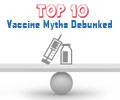Immunization against “death star” strain of an HIV-related laboratory virus (SIVmac239) and another tough strain is successful.

‘Use of adeno associated virus in concert with eCD4 helps to prevent HIV infection. This approach is safe for both infected and at-risk persons in a cost-effective manner.’
Read More..




Lead authors Michael Farzan, PhD, and Mathew Gardner, PhD, describe their destruction of the "death star" strain and another especially hard-to-fight strain, suggesting it may be possible to protect uninfected individuals from multiple forms of HIV.Read More..
Their nontraditional vaccine achieved another critical goal: durability. This means it protected the research animals from infection long-term, with a single inoculation, Farzan says.
"We have solved two problems that have plagued HIV vaccine studies to date--namely, the absence of duration of response and the absence of breadth of response," Farzan says. "No other vaccine, antibody or biologic protects against the two viruses for which we have demonstrated robust protection."
Globally, about 180,000 new HIV infections occur in children annually, according to UNAIDS, and about 1 million people a year die of HIV/AIDS-related illnesses. Developing an HIV vaccine that protects long-term with a single dose is an important goal, especially in places where medical resources can be scarce, anti-retroviral drugs may be unavailable, and the risk of mother-to-infant transmission of HIV can be high.
The Farzan group's work adds to the significant mark that Scripps Research is making in the fight against HIV. The institute announced that the Scripps Consortium for HIV/AIDS Vaccine Development (CHAVD), an international collaboration led by Scripps Research, been awarded a $129 million, seven-year award from the National Institutes of Health to advance next-generation vaccines. Conventional vaccine approaches typically use a piece of virus or other immunogen to activate an immune system response. Because HIV replicates and changes so quickly, that approach has proven challenging. Farzan's approach uses a safe virus to fight the dangerous one, and relies on muscle cells rather than immune cells to generate protective agents. Here's how: A harmless, lab-made adeno-associated virus (AAV) carries within it a protective protein designed by Farzan and colleagues to stop HIV infectivity.
Advertisement
Primates are the only animals, other than humans, that support replication of these viruses. There's much more work to be done, notes first author Gardner. The study showed that the research animals could eventually become infected when exposed to atypically large loads of HIV. It also showed that HIV is capable of developing resistance to eCD4-Ig, albeit in a much-weakened state.
Advertisement
The use of AAV as a gene therapy tool has generated considerable excitement recently, gaining FDA approval for genetic diseases including inherited retinal disease and spinal muscular atrophy. This study shows it also has the potential save lives used as a protective vaccine, Farzan says.
"The results of our paper are encouraging for the potential of AAV as a platform for prevention of disease generally, and in concert with eCD4 as an agent for stopping HIV infection," Farzan says. "We hope ultimately to prove that our approach is safe for both infected and at-risk persons at a cost that makes it useable everywhere."
Source-Eurekalert








